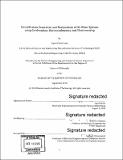Emulsification, separation, and manipulation of oil-water systems using condensation, electrocoalescence, and electrowetting
Author(s)
Guha, Ingrid Fuller.
Download1127289813-MIT.pdf (6.384Mb)
Other Contributors
Massachusetts Institute of Technology. Department of Electrical Engineering and Computer Science.
Advisor
Kripa K. Varanasi.
Terms of use
Metadata
Show full item recordAbstract
This thesis explores the emulsification, separation, and manipulation of oil/water mixtures using a range of chemical, mechanical, and electrical techniques. Simply explained, this thesis reports new methods to emulsify oil and water using condensation, separate oil and water using low-voltage electrocoalescence, and manipulate oil and water using ultra low-voltage electrowetting. The emulsification method relies on condensation of one liquid phase onto another. As nanoscale droplets of water condense onto the surface of oil, they are submerged and stabilized in the oil by a surfactant in the oil phase. The concentration of surfactant and time of condensation determine the size and stability of the resulting emulsions. The separation method presented in this thesis redesigns the configuration of the standard electrocoalescence setup and the dielectric materials used. The design employs a surface configuration in place of a bulk configuration for electrocoalescence. Additionally, a high-K dielectric (hafnium oxide) is used in place of a hydrophobic low-K dielectric (e.g. a fluoropolymer). A thermodynamically stable nanoscale oil film-a lipid bilayer-forms on the surface of the hafnium oxide, effectively rendering the surface hydrophobic by buffering water drops from the surface and preventing pinning. This surface configuration coupled with the use of a high-K dielectric drastically reduces the voltage required to induce electrocoalescence. The method of manipulating oil and water presented in this thesis is the electrowetting of a water drop on bare silicon in an oil environment containing zwitterions. The zwitterions form a nanoscale lipid bilayer between the water drop and the silicon surface. This electrowetting system contains no deposited solid dielectrics, resulting in ultra low-voltage actuation of the electrowetting effect. This thesis presents the theory, experimental results, and discussion of the experimental results for each method of controlling water/oil mixtures.
Description
Thesis: Ph. D., Massachusetts Institute of Technology, Department of Electrical Engineering and Computer Science, 2018 Cataloged from PDF version of thesis. Includes bibliographical references (pages 53-60).
Date issued
2018Department
Massachusetts Institute of Technology. Department of Electrical Engineering and Computer SciencePublisher
Massachusetts Institute of Technology
Keywords
Electrical Engineering and Computer Science.